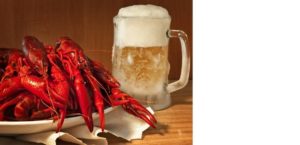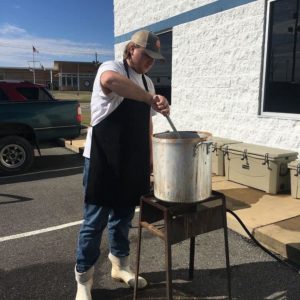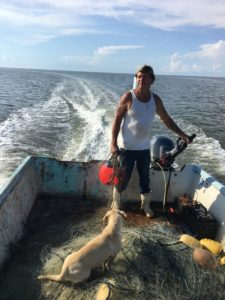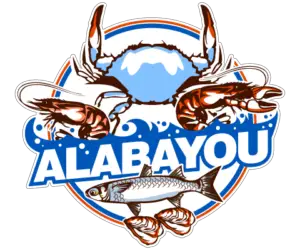When you’re lucky enough to grow up in the south it is a common tradition to throw or go to crawfish boils.
I’ve catered hundreds of crawfish boils and I’m always running into people who are not familiar with this awesome southern Tradition.
So just what is a crawfish boil? A crawfish boil is a traditional and popular culinary event in the southern United States, especially in Louisiana, where it is often held as a social gathering and celebration. It is a delicious and fun way to enjoy fresh crawfish, also known as crayfish or mudbugs, along with other seafood, vegetables, and seasonings.
Lets take a deeper look into crawfish boils and, see why so many people’s favourite season is crawfish season.

The Main Course of a Crawfish Boil
The main ingredient in a crawfish boil is, of course, the crawfish. These freshwater crustaceans are typically boiled alive in a large pot with a mixture of spices, seasonings, and vegetables, including onions, garlic, potatoes, corn, and lemons.
The boil is typically flavored with a combination of herbs and spices, such as cayenne pepper, paprika, and bay leaves, that give the crawfish their signature flavor and heat.

People can’t get enough boiled crawfish when you leave in the south you will find yourself going to severel crawfish boils during the spring months.
Process of The Crawfish Boil:
The process of preparing a crawfish boil starts by selecting fresh, live crawfish and cleaning them thoroughly. Next, the pot is filled with water, and the spices and seasonings are added.
The vegetables and crawfish are then placed in the pot and boiled for about 10-15 minutes, or until the crawfish are cooked through.

If you would like to learn more about boiling crawfish check out our in-depth guide.
To Purge or Not Purge That is The Question
Whenever you go to crawfish boil you will find people discussing if the crawfish have been purged. Purging crawfish refers to the process of cleaning live crawfish before cooking them.
Purging is done to remove any dirt, debris, or impurities that might be inside the crawfish, as well as to help improve the flavor of the cooked crawfish.
Some people will tell you that is not necessary I would avoid any crawfish that have not been properly purged. We have discussed the importance of purging crawfish in an article here.
Key Components to a Crawfish Boil
A successful crawfish boil involves several key components, including:
- Quality crawfish: It all starts with high-quality, live crawfish. Look for crawfish that are lively and active, and avoid ones that are limp, discolored, or have a strong odor.
- Clean the Crawfish: Purging is a critical step in preparing crawfish for cooking and serving, and it should not be skipped.
- Seasoning mix: A good crawfish boil requires the right blend of spices and seasonings. The most common seasonings include seafood boil, garlic, onion, lemon, and bay leaves.
- Cooking Equipment: You’ll need a large pot, usually aluminum, with a basket to hold the crawfish, and a propane burner to heat the water. This is just the bare minimum you need to cook crawfish, there are several accessories that help in preparing crawfish
- Sides: Crawfish boils are often served with traditional side dishes, such as potatoes, corn on the cob, robe sausage, and mushrooms. Choose sides that complement the flavors of the crawfish and the seasonings used in the boil.
With these key components, you’ll have all the tools and resources for a delicious and successful crawfish boil.

Social Gathering
Once the boil is ready, it is typically served in a large newspaper-lined table for diners to enjoy. Diners will peel the crawfish themselves then enjoy the succulent meat along with the juicy, flavorful vegetables and spices.
Some people like to suck the head of the crawfish to extract the flavorful juices, while others prefer to peel and eat the tail meat.
If you’re curious as to what crawfish taste like check out our post here.
In addition to the food, a crawfish boil is also about the experience. It is a social gathering where friends and family come together to share food, drink, and good times.
The atmosphere is often lively, with music, laughter, and conversation filling the air.A crawfish boil is a delicious and fun way to enjoy fresh crawfish and other seafood, along with a variety of flavorful spices and seasonings.

It is a celebration of southern cuisine and culture, and a tradition that is cherished by many.
Whether you are a seasoned crawfish boil expert or a newcomer to the experience, a crawfish boil is a delicious and unforgettable experience that everyone should try at least once in their lifetime.
“Keeping Tradition”
At Alabayou, we believe that preserving the traditions and heritage of commercial fishing families and communities is of utmost importance.
Commercial fishing is more than just a job; it is a way of life that has been passed down from generation to generation for centuries.
However, with real estate development and over regulations threatening coastal towns and communities across the country, these traditions are at risk of being lost forever.
That’s why Alabayou was created, to help preserve and promote the rich history and cultural significance of commercial fishing.
Our mission is to bring together commercial fishing families, communities, and organizations to share their stories, experiences, and knowledge with others.

Whether you are a commercial fisherman, a passionate seafood enthusiast, or simply someone who appreciates the beauty and importance of our coastal heritage, Alabayou is the place for you.
We offer a variety of resources and information to help support and sustain the commercial fishing industry, including industry news, historical articles, and community events.
At Alabayou, we understand that the commercial fishing industry is facing many challenges, but we believe that by working together and sharing our passion and knowledge, we can help ensure that these traditions and way of life continue for generations to come.
Join us in our mission to preserve and celebrate the commercial fishing heritage of our country. Help support Alabayou today!

